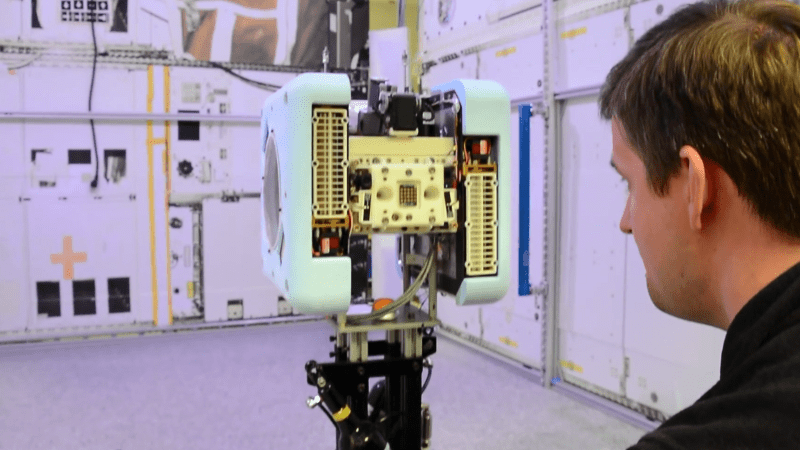It may look more like a Companion Cube than R2-D2, but the ISS is getting an astromech droid of sorts.
According to [Trey Smith] of the NASA Ames Research Center, Astrobee is an autonomous robot that will be able to maneuver inside the ISS in three dimensions using vectored thrust from a pair of turbines. The floating droid will navigate visually, using a camera to pick out landmarks aboard the station, including docking ports that let it interface with power and data. A simple arm allows Astrobee to grab onto any of the hand rails inside the ISS to provide a stable point for viewing astronaut activities or helping out with the science.
As cool as Astrobee is, we’re intrigued by how the team at Ames is testing it. The droid is mounted on a stand that floats over an enormous and perfectly flat granite slab using low-friction CO₂ gas bearings, giving it freedom to move in two dimensions. We can’t help but wonder why they didn’t suspend the Astrobee from a gantry using a counterweight to add that third dimension in. Maybe that’s next.
From the sound of it, Astrobee is slated to be flight ready by the end of 2017, so we’ll be watching to see how it does. But if they find themselves with a little free time in the schedule, perhaps adding a few 3D-printed cosmetics would allow them to enter the Hackaday Sci-Fi Contest.
















So is this a followup too https://en.wikipedia.org/wiki/SPHERES or something entirely different? because it sounds like they try achieve the same goals?
SPHERES was very, very, limited, there are off the shelf drones with more actual features, it seems their primary job was research into that type of locomotion and navigation, with a limited use for observing and assisting, the only real experiment that i can find the spheres were integral to were the SLOSH experiments.
this looks like it can do a lot more.
In the video at the top of the article they mention they’re a replacement for the SPHERES system.
“According to [Trey Smith] of the NASA Ames Research Center, Astrobee is an autonomous robot that will be able to maneuver inside the ISS in three dimensions using vectored thrust from a pair of turbines.”
Turbine: Extracts power from a moving fluid and uses it to rotate a shaft
Fan/Impeller/Compressor: Extracts power from a rotating shaft and uses it to move a fluid
The general public doesn’t know the difference, and tends to call any fan with closely-spaced blades in a shroud a “turbine”.
Also, if you watch the video, he does correctly refer to them as impellers.
Technically, could you not blow air through an impeller to extract power from its DC motor?
That’s not the function for which it is optimized, but it would work.
A room sized optically flat slab of granite! Ye Gods!
Yah, sheesh, us plebs have to make do with a few square feet of countertop offcuts for our optically flat granite needs.
probably not optically flat, just very flat.
Would have been easier to pour an epoxy slab, which naturally shapes itself with an extremely slight curve thanks to gravity. There’s a company in the southeast USA that does those air bearing floors, and epoxy setup platforms for NASCAR and other racing teams. They were doing the race car thing first, then some company asked if they could coat an entire floor to the same level of precision.
Cast epoxy air bearing floors have been around since at least the late 80s to early 90’s. I remember a magazine article about one NASA had made, but their floor prep wasn’t quite good enough. The epoxy curled up around the edges and also a spot in the middle came loose, making a “hump” a few thousandths of an inch high, so they programmed their platform control system to work around the edges and hump. Probably been torn up and redone long since, or the room repurposed.
The hard part was getting it off the moon where they found it.
Guilty spark?
I was thinking the same thing. It needs to roam the space station and hum tunelessly to itself. Maybe say some random dialog about how the astronauts need to upgrade to a class 12 combat skin
This was all I could think of when I saw that: https://www.youtube.com/watch?v=7NpHuAYTkSU
I want to see a homage to GERTY from the 2009 film Moon.
http://hackaday.com/2016/07/11/the-dubious-claim-of-a-world-helium-shortage/#comment-3085150
Excellent film; hard science fiction with no aliens or ‘AI goes crazy’ storyline.
That room sized optically flat slab of granite is probably left over from the Hubble mirror project. ;-)
Wasn’t this supposed to be spherical? In any case, “MAX AND JINX… FRIENDS FOREVER.” :P
I fear the gantry and counterweight idea is doomed – if it moves upwards the CO2 gas bearings will stop working – they need to float only just above the granite surface – and movement downwards is definitely out…
“gantry using a counterweight to add that third dimension in” NASA has plenty of experience using counterweights, cables and pulleys to fake weightlessness in the moon landing footage.
The Canadarm remote manipulator systems used on the US space shuttles and the ISS were tested the same way: http://www.asc-csa.gc.ca/images/canadarm/ngc-grand-canadarm-span3.jpg
Optically flat floor not required. Polished concrete is fine.
Not sure I’d call Moon a hard science movie given the ending, but definitely a good movie.
Did anyone else think of Bob and Vincent from Disney’s “The Blackhole”
https://youtu.be/9bGOsQFMEbs
” using a camera to pick out landmarks aboard the station”
I don’t know, the ISS is awfully messy, maybe they should put some IR LED on strategic locations instead.